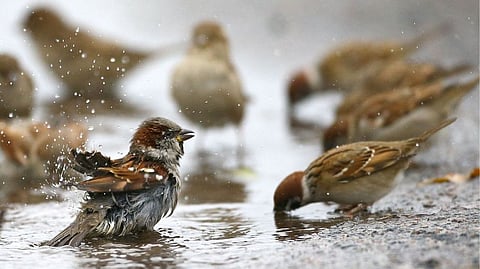

NEW DELHI: In the backdrop of World Sparrow Day, which was observed earlier this week, it seemed pertinent to note the manner in which sparrow populations across the country had been declining in a drastic manner since the 1990s.
As per an ornithological survey conducted by the Indian Council of Agricultural Research (ICAR), the population of sparrows in Andhra Pradesh had dipped by 80%.
In other states like Kerala, Gujarat and Rajasthan, the numbers had dropped by 20%. Coastal areas reported a drop in the population as steep as 70% to 80%.
A similar tale played out in metros like Mumbai and Kolkata, and mega-cities like Bengaluru, Hyderabad and Gurugram, which are now blazing through with industrialisation and urbanisation on an unprecedented scale.
Several research papers have attempted to unravel the causes of such losses in India’s fauna ecosystem. One of the primary culprits happens to be modernisation and urbanisation across large pockets of the country.
The cold and calculated manner in which modern buildings are constructed, keeping only the interests of the human denizens in mind, is a major contributor to this loss.
There is an acute absence of nest holes in modern residential and commercial complexes. In cities like Ahmedabad, the concept of a chabutra, or a nesting tower for pigeons and other birds, used to be a mainstay of architecture.
Unfortunately, few gated communities or buildings bother to incorporate such symbiotic structures into their premises.
Apart from the lack of nesting zones, there is also the bane of traffic plying 24/7 on city roads. Greater volume of traffic results in increased noise, air and light pollution all of which adversely impacts the growth of small birds such as sparrows.
Man-made causes aside, sparrow numbers have also declined because of increased predation by larger birds, competition for food from various urban species, and diseases as well.
Having said that, there seems to be hope at the end of the tunnel.
A recent, updated study called the State of India’s Birds (SIB) 2000, which was published in 2020, suggested that the population of house sparrows has been stabilising during the past two decades.
The report said that owing to the extremely large range of the species across India and due to lack of evidence for either long-term or current countrywide decline, house sparrows have been classified as a species of low conservation concern.
The Salem Ornithological Foundation has also confirmed that the distribution of sparrows has become stable in Tamil Nadu and Puducherry.
However, the SIB report also mentioned a large-scale decline in a majority of species. Long term trends were available for 261 species, of which 52% have declined since 2000, and 22% declining strongly.
Raptors, migratory shorebirds, white-rumped vultures, Richard’s Pipit, Indian vultures, large-billed leaf warblers, Pacific Golden Plovers and curlew sandpipers were among the most vulnerable.
About 43% of species exhibited a long term trend that was stable, while 5% showed a rising trend.
Needless to say, the efforts of conservationists across India need to be supported not just by citizens, but by the governments as well, through the creation of grants, funding programmes and awareness initiatives.
The roles played by birds in enriching our ecosystems cannot be overstated — from pollination to pest control, increasing diversity and more. It is therefore essential that we do our part in keeping up this delicate balance.
Visit news.dtnext.in to explore our interactive epaper!
Download the DT Next app for more exciting features!
Click here for iOS
Click here for Android